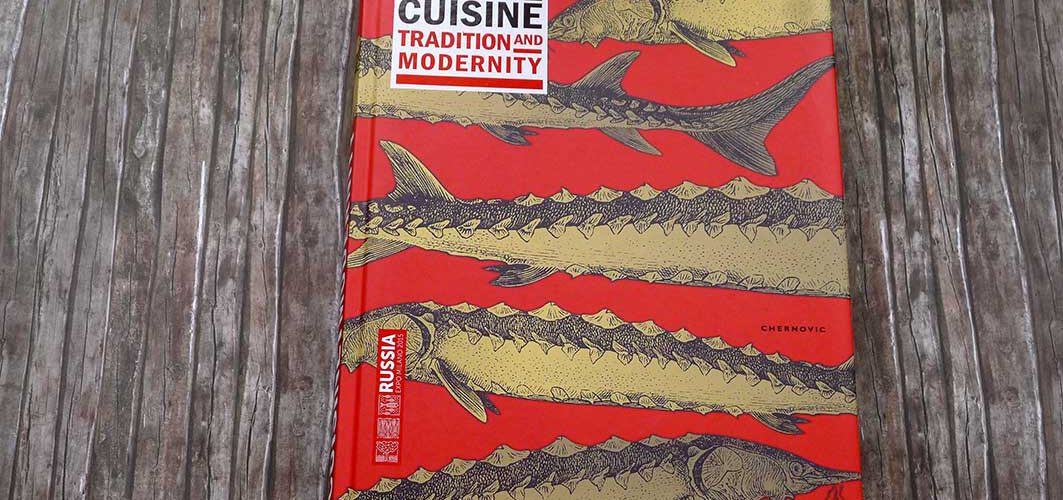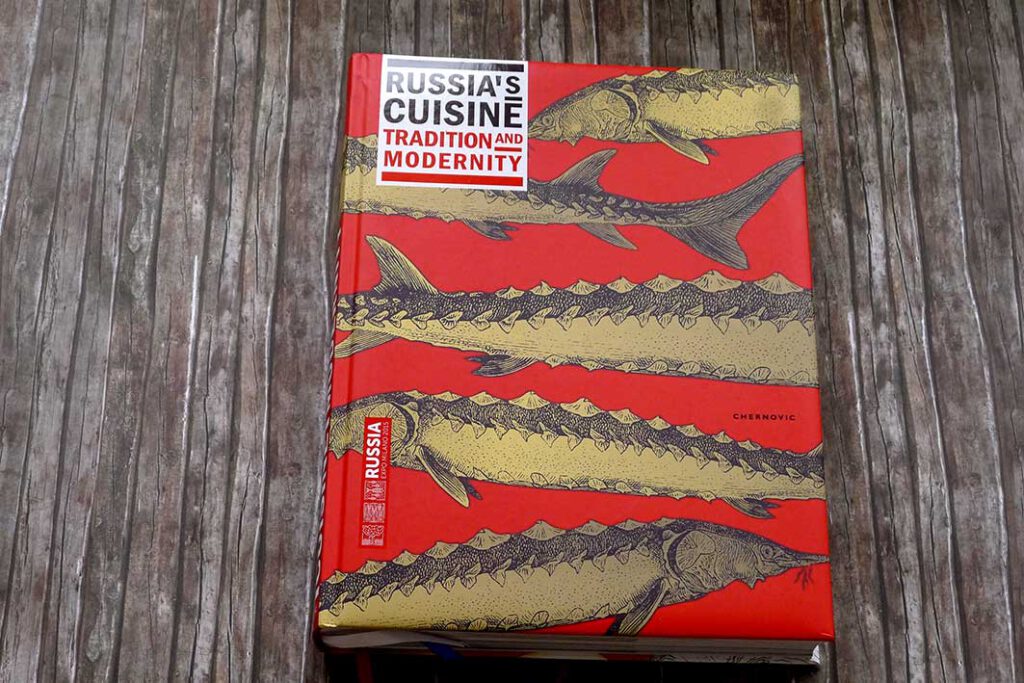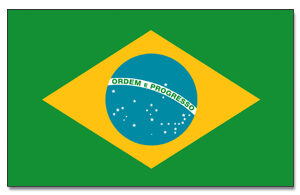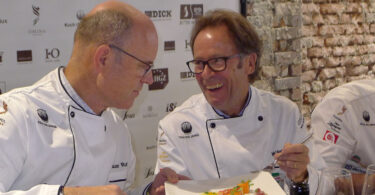Russia’s Cuisine, Tradition and Modernity, Chernovic
Feeding the Planet, Energy for life
This was the slogan of Expo 2015 in Milan.
Technology, innovation, culture and creativity were then combined with the themes of nutrition and food.
The Expo saw itself more as a discussion forum than as a showcase for performance.
Especially for this Expo the Gastronomic Publishing House, Chernov and Co. published “Russia’s Cuisine, Tradition and Modernity”.
In his preface Igor Bukharov, President of the Russian Hotelier and Restaurant Association, writes about this book and Russian cuisine:
Russia’s Cuisine is not an encyclopedia, much more it spans a culinary arc over this huge country with over 180 ethnic groups.
The editor Sergey Chernov is an excellent publicist, eloquent and with an eye for detail and aesthetics. Under his direction, “Le Grand Larousse Gastronomique” was translated into Russian and published in several volumes. The key works of Alain Ducasse were also translated, edited and published by the Gastronomic Publishing House.
The English edition at my hands is impressive! On over 456 large and richly illustrated pages, Chernov draws a truly captivating picture of his home cuisine.
Each chapter describes a particular region, the people and their cuisine.
Special features are characterized equally multi-faceted and entertaining.
Russian cuisine is clearly more than vodka and caviar!
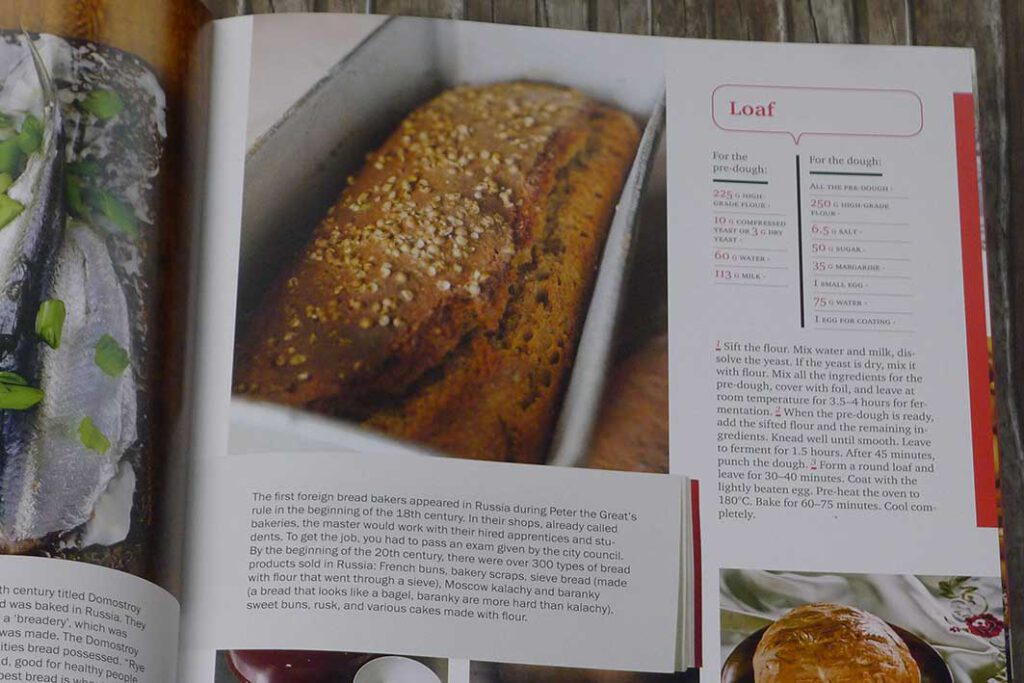
Central Russia
The culinary journey begins in Central Russia. Bread is one of the most important foods, baked with rye flour, buckwheat flour and wheat flour.
The Borodino bread, almost a symbol of Russian cuisine, is known throughout the country. Its sweet rye aroma with a hint of coriander is unique.
No festive table, no celebration, no party without a cake or pâté! The fillings are varied and colourful.
Russia’s abundance of fish is legendary, large rivers such as the Don, Volga or Dnepr and numerous lakes provide a large selection of freshwater fish.
Catfish and pike are at the top of the menu, the latter is often prepared with sour cream and horseradish, delicious!
Very exclusive is the Olivier salad with crayfish, quail eggs, chicken or quail breast and caviar.
The Beef Stroganoff is one of the most famous dishes from the region. It was named after the Russian Minister of the Interior Alexander Stroganov (1795 – 1891). The recipe requires a special tomato sauce, which in preparation and taste differs substantially from the Italian sauces known to us.
The Russians are particularly proud of their apple varieties, a whole chapter with detailed illustrations is dedicated to them.
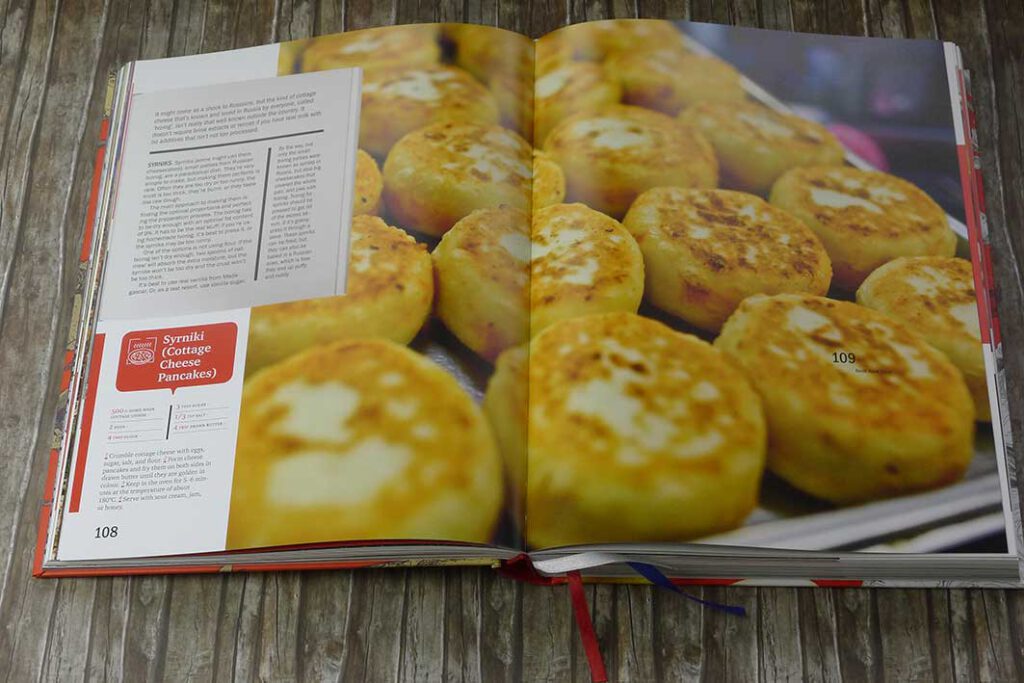
Northwest Russia
In the chapter about Northwest Russia we learn how the production of the delicious syrinkis works. These small, baked cheese cakes are made from cottage cheese, eggs, if necessary some flour, sugar, salt, butter and fine Madagascan vanilla. The secret is the Tvorog, the cottage cheese. It must neither be too liquid nor too dry, great masters know how to prepare these dessert cakes without flour.
The name of the Russian physicist Dmitri Ivanovich Mendeleev invisibly runs through the book like a red thread.
His periodic table is cited in selected recipes. These are hints to elements that our body needs. We learn by the way that the potassium in the onion stimulates the muscle activity, very sophisticated!
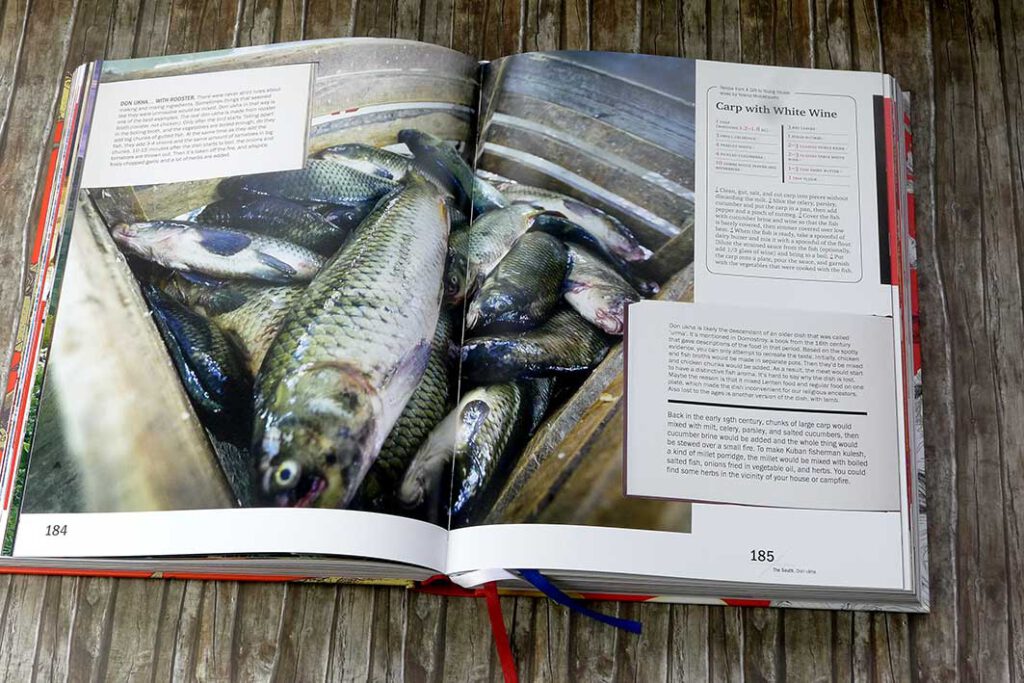
The North
In the north there is plenty of fish! The proximity to Scandinavia is obvious, Kalakkuko sounds almost Finnish.
It is a cake made of chopped fish, onions and flour, not necessarily my taste.
However, the salmon in the parchment has a Mediterranean touch. It is wrapped in parchment with some celery, small carrots, thyme and olive oil and steamed glassy, wonderful!
At Christmas the perfume of the Blini is flowing through the streets. The little pancakes are as much a part of the festivities as the Christmas cookies!
The Russian ethnologist Tereshchenko writes about about it:
Blinis are baked all day long, from buckwheat or wheat flour, with eggs, milk and butter. In rich houses they are served with caviar. They are offered hot everywhere, they don’t taste cold anymore.
Vodka and blinis, more than life, that’s Malenitsa (a Russian celebration)!
The South
In the south the sun is shining, vegetables and delicious fruits are harvested abundantly. One sits relaxed at the beaches of the Black Sea, from a harbour restaurant the smell of grilled meat dances into the nose. The Taman Peninsula, Abrau-Durso, Anapa, Gelendzhik, Tuapse, Temryuk, all these places form the tones of a sonorous melody that enchants our soul.
Varenikis are characteristic of the cuisine of the south, the dumplings are filled either sweet or salty. The dough, sometimes refined with kefir, is rolled out very thinly, the filling – if it consists of meat – is always pre-cooked, the vegetables or fruits are pickled before processing.
Varenies are delicious marmalades, jams and fruit preparations with sugar. International gourmet circles do distinguish between an English jam and a Russian varenie. Technically, there are four types of production:
There are varenies where the fruit is boiled in its own juice and the fruit is pre-macerated. There are Varenies with honey, there are Varenies that are made with the addition of syrups and finally the Varenies that are prepared in the oven.

Dagestan
The journey continues to Dagestan, a multicultural region inhabited by Avars, Agulas, Dargines, Kumyks, Sheets, Lesgines, the Tât, Tabassarans, Nogaians, Tschahurs and Chechens. The traditional food is called Khinkali.
Dough pieces are cooked in the meat broth and then served with boiled meat and a sauce. The area is poor in vegetables but rich in spices, so people like to grill lamb or beef skewers over the fire.
A special delicacy is the walnut jam made from whole nuts. The complex production process requires patience and experience. The nuts are soaked for two weeks, the water is changed twice a day, after all they are so soft that they can be pierced with a needle. In the end, the nuts are cooked in several stages and seasoned with herbs and lemon juice, a science!
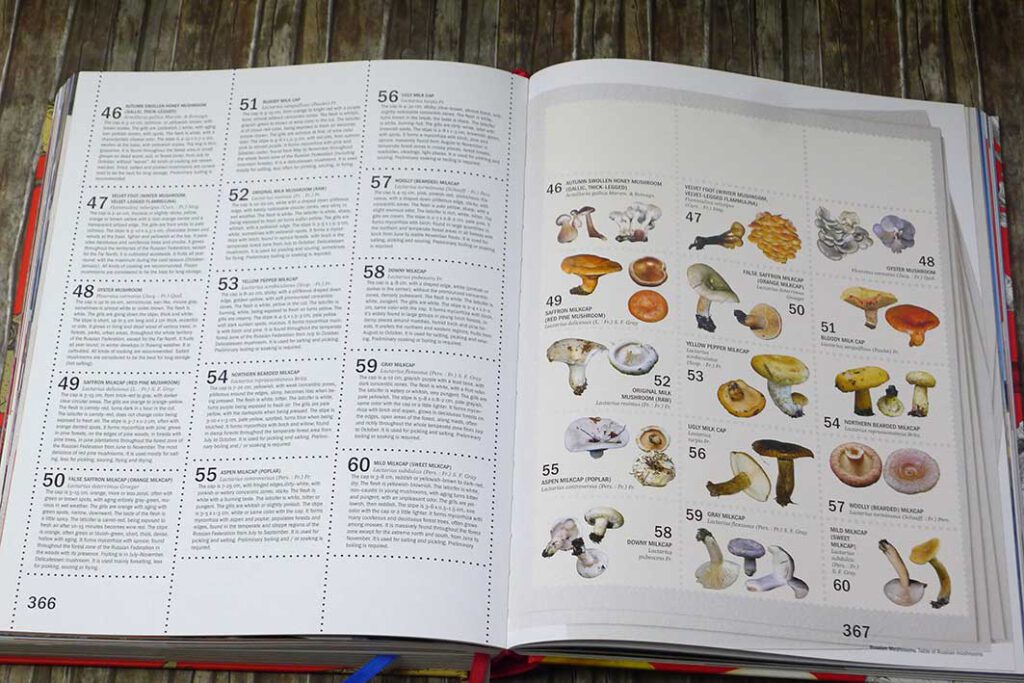
Mushrooms
Mushrooms occupy a special place in Russian cuisine and a whole chapter is dedicated to them. The number of mushroom species in Russia is amazing, as is the quantity harvested. Evaluations showed that Russians consume on average ten kilograms of mushrooms per year.
The tasty forest plants have always been extremely popular, serving as a meat substitute in hard times.
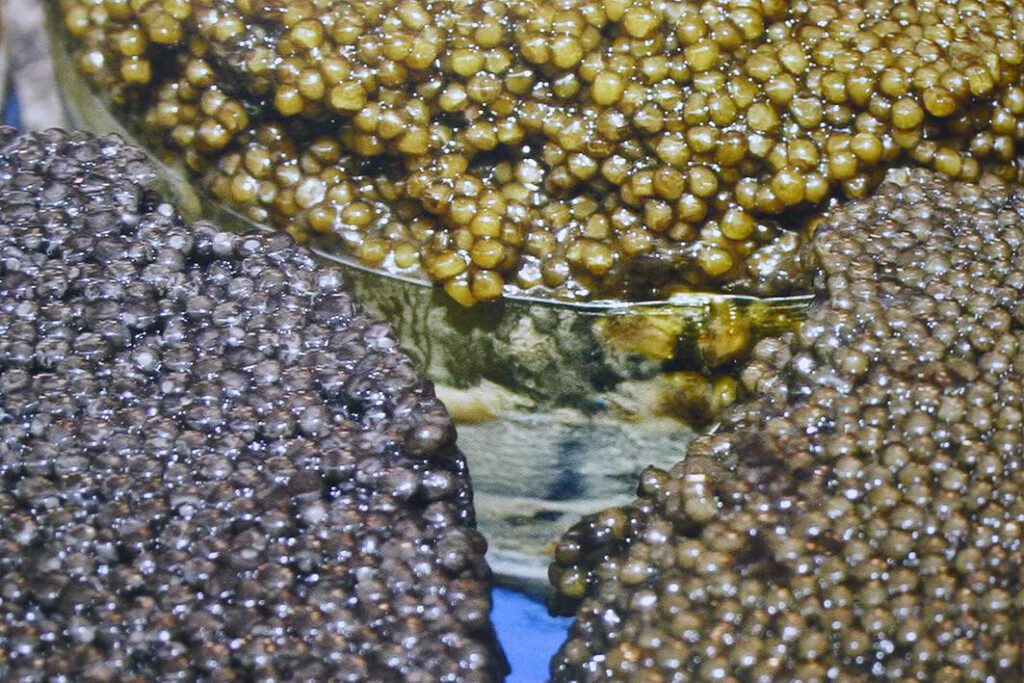
Caviar
What would a book on Russian cuisine be without a chapter on caviar? The Beluga caviar, the black gold of the Volga, comes from Astrakhan. Sevruga caviar is not quite as expensive and of high quality, it is somewhat smaller and darker. The lighter and bigger the eggs, the more valuable the caviar.
There is pressed Sevruga caviar, which gleams with its fine butter aroma.
Black caviar has been consumed in Russia for a long time, but in pre-revolutionary times it was actually more of a man-poor meal.
The British William Coxe tells of a celebration that Catherine the Great organized for the population in her summer garden in 1778:
The table was littered with all sorts of meat: pyramids of bread slices with caviar piled up, there were dried sturgeons, carp and other fish decorated with lobsters, onions and cucumbers.
Today caviar is obtained from aquacultures and fishing in the Caspian Sea has been banned.

Modern Russian Cuisine
The developments of the last twenty years have not left Russia untouched. Molecular cuisine, tasting menus, culinary construction and deconstruction – this vocabulary made its way into the restaurant kitchens of upscale gastronomy some time ago.
Again and again sanctions are imposed against Russia, so that chefs know how to handle them creatively. If at all possible, regional products are used; a virtue is made of necessity. In his “White Rabbit” in Moscow, the highly decorated star chef Vladimir Mukhin serves Buckwheat porridge with roasted duck hearts, mushrooms, pine nuts and a moss sauce.

Personally, I don’t mind that there is no register of recipes. I talked about it with the publisher Sergey Chernovic. His idea is to present the diversity and richness of Russian cuisine in this book, which is an enrichment for the international audience and an inspiration for Russian readers.
Produktinformation
- Ledereinband: 456 Seiten
- Verlag: Chernova Sergei Petrovich (19. Oktober 2016)
- Sprache: Englisch
- ISBN-10: 5989370679
- ISBN-13: 978-5989370672
- Größe und/oder Gewicht: 24,5 x 4,7 x 32,3 cm
Das Buch beziehen Sie am besten direkt beim Verleger: http://chernovic.com
![[:de]Grandgourmand, Travel, Food, Lifestyle[:]](https://grandgourmand.de/wp-content/uploads/2023/01/logo_23_1-1.png)
